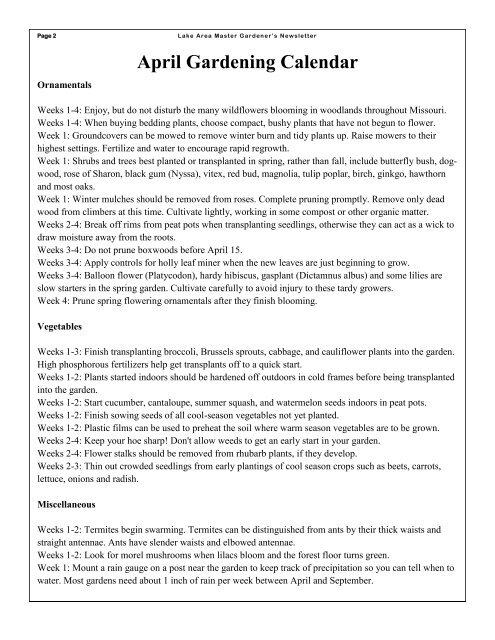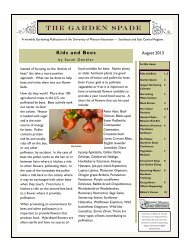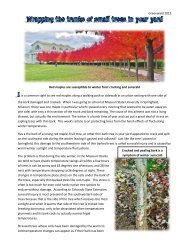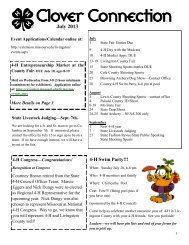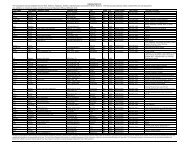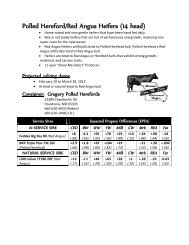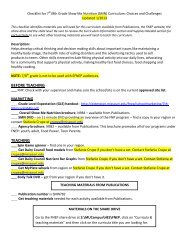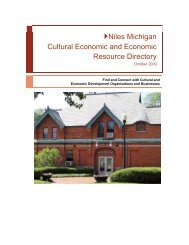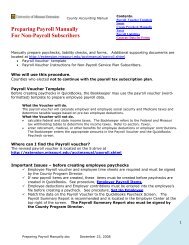Newsletter - University of Missouri Extension
Newsletter - University of Missouri Extension
Newsletter - University of Missouri Extension
Create successful ePaper yourself
Turn your PDF publications into a flip-book with our unique Google optimized e-Paper software.
Page 2<br />
Ornamentals<br />
Lake Area Master Gardener’s <strong>Newsletter</strong><br />
April Gardening Calendar<br />
Weeks 1-4: Enjoy, but do not disturb the many wildflowers blooming in woodlands throughout <strong>Missouri</strong>.<br />
Weeks 1-4: When buying bedding plants, choose compact, bushy plants that have not begun to flower.<br />
Week 1: Groundcovers can be mowed to remove winter burn and tidy plants up. Raise mowers to their<br />
highest settings. Fertilize and water to encourage rapid regrowth.<br />
Week 1: Shrubs and trees best planted or transplanted in spring, rather than fall, include butterfly bush, dogwood,<br />
rose <strong>of</strong> Sharon, black gum (Nyssa), vitex, red bud, magnolia, tulip poplar, birch, ginkgo, hawthorn<br />
and most oaks.<br />
Week 1: Winter mulches should be removed from roses. Complete pruning promptly. Remove only dead<br />
wood from climbers at this time. Cultivate lightly, working in some compost or other organic matter.<br />
Weeks 2-4: Break <strong>of</strong>f rims from peat pots when transplanting seedlings, otherwise they can act as a wick to<br />
draw moisture away from the roots.<br />
Weeks 3-4: Do not prune boxwoods before April 15.<br />
Weeks 3-4: Apply controls for holly leaf miner when the new leaves are just beginning to grow.<br />
Weeks 3-4: Balloon flower (Platycodon), hardy hibiscus, gasplant (Dictamnus albus) and some lilies are<br />
slow starters in the spring garden. Cultivate carefully to avoid injury to these tardy growers.<br />
Week 4: Prune spring flowering ornamentals after they finish blooming.<br />
Vegetables<br />
Weeks 1-3: Finish transplanting broccoli, Brussels sprouts, cabbage, and cauliflower plants into the garden.<br />
High phosphorous fertilizers help get transplants <strong>of</strong>f to a quick start.<br />
Weeks 1-2: Plants started indoors should be hardened <strong>of</strong>f outdoors in cold frames before being transplanted<br />
into the garden.<br />
Weeks 1-2: Start cucumber, cantaloupe, summer squash, and watermelon seeds indoors in peat pots.<br />
Weeks 1-2: Finish sowing seeds <strong>of</strong> all cool-season vegetables not yet planted.<br />
Weeks 1-2: Plastic films can be used to preheat the soil where warm season vegetables are to be grown.<br />
Weeks 2-4: Keep your hoe sharp! Don't allow weeds to get an early start in your garden.<br />
Weeks 2-4: Flower stalks should be removed from rhubarb plants, if they develop.<br />
Weeks 2-3: Thin out crowded seedlings from early plantings <strong>of</strong> cool season crops such as beets, carrots,<br />
lettuce, onions and radish.<br />
Miscellaneous<br />
Weeks 1-2: Termites begin swarming. Termites can be distinguished from ants by their thick waists and<br />
straight antennae. Ants have slender waists and elbowed antennae.<br />
Weeks 1-2: Look for morel mushrooms when lilacs bloom and the forest floor turns green.<br />
Week 1: Mount a rain gauge on a post near the garden to keep track <strong>of</strong> precipitation so you can tell when to<br />
water. Most gardens need about 1 inch <strong>of</strong> rain per week between April and September.


